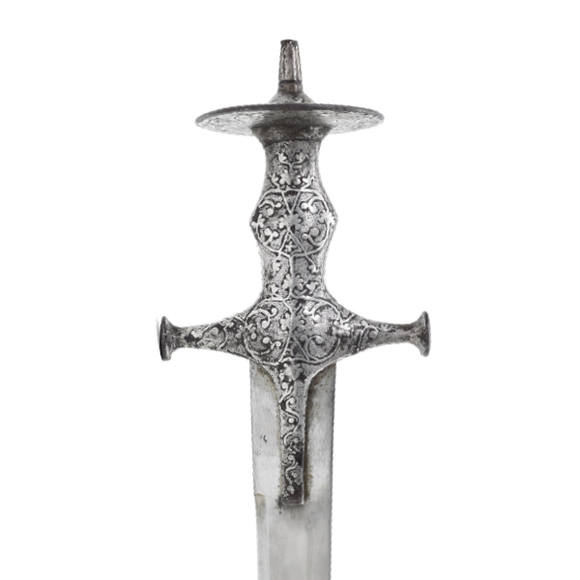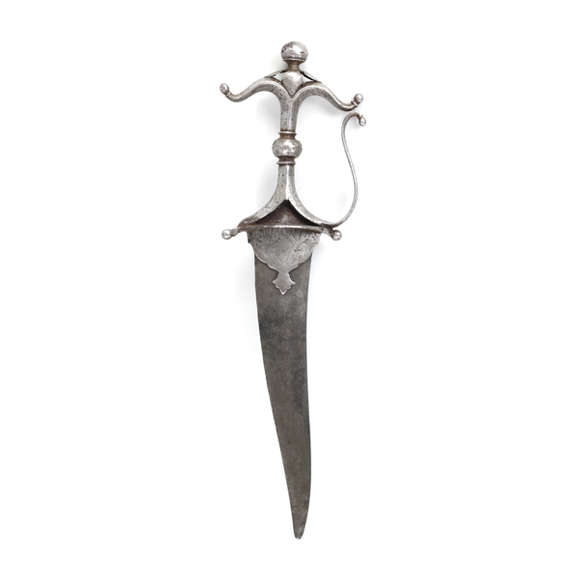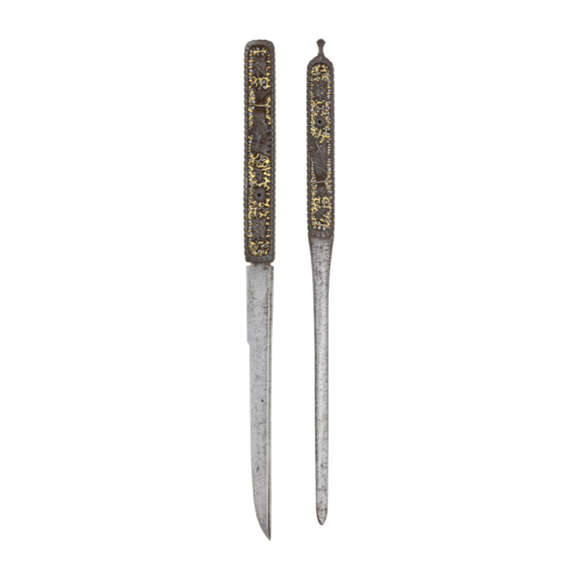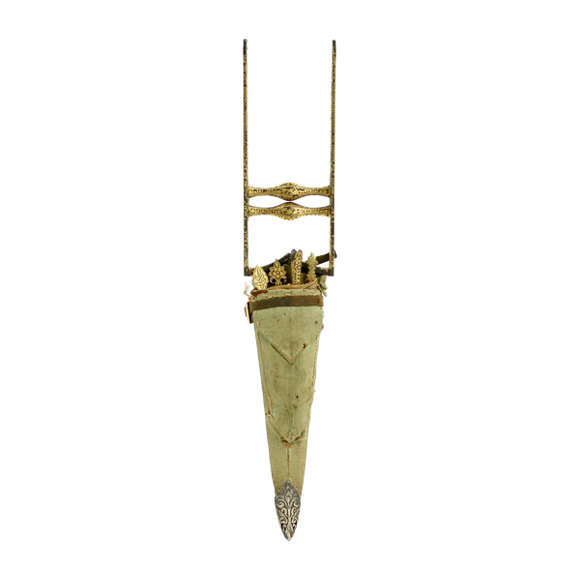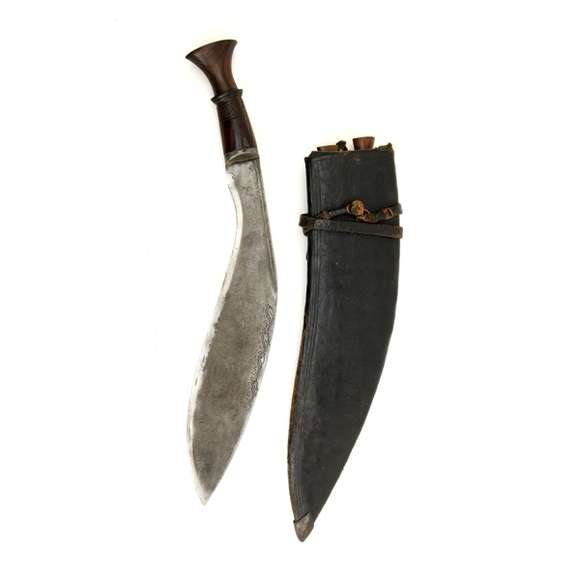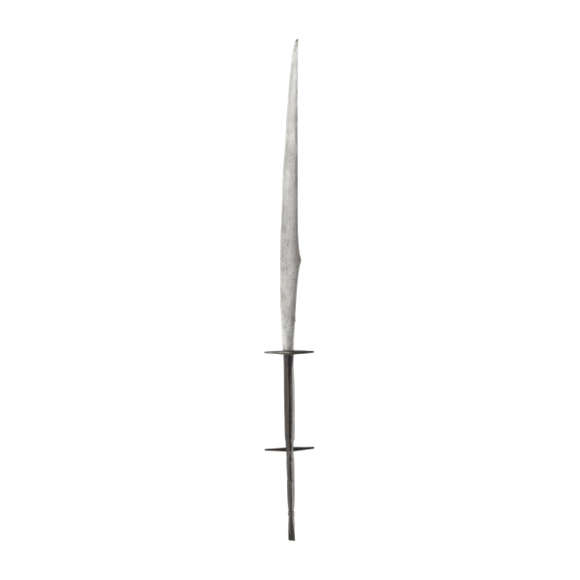The hilt is in the typical Marwari Rajput style, made by Ram Namar in 1857 A.D.

Sheathed 104 cm
Sword 93.5 cm
82 cm
(to center crossguard)
Base 6.5 mm
Middle 5 mm
Start backedge 4 mm
5 cm from tip 2 mm
Base 38.5 mm
Middle 37.5 mm
Start backedge 39.5 mm
959 grams
17 cm from hilt
Iron, steel, silver, gold, wood, silk velvet, brass, resin
The Deccan, India
18th to early 19th century
Introduction
This talwar comes from the Fraser brothers, passed down in their family. They were known primarily in the art world for the famous "Fraser album", a series of paintings commissioned by top Delhi artists that depict North India and Indian life during his time. It was the start of a genre now known as the Company style. The album is now scattered over a number of private and institutional collections.1
James Baillie Fraser (1783-1856) was an artist and travel writer who wrote, among others: Narrative of a journey into Khorasan, in the years 1821 and 1822 and Travels and Adventures in the Persian Provinces of the Southern Banks of the Caspian Sea.2
His brother William Fraser (1784-1835) was a spirited British civil servant, involved in various battles, and the first to recruit Ghurkas for the British army. He had various scars, including two saber cuts on the arm, a wound from a pike in the back, and an arrow that was shot through his neck.3
When his brother James visited William's place in Delhi in March 1815 he noted:
"Certainly William's house is a curiosity. Tygers' skins, caps of Tyger's heads, saddle cloths of ditto, quantities of saddlery, matchlocks, bows and arrows, quivers, belts, armour, guncases. All his guns and swords had gone to Nahan for him being with the army. Persian books and curiosities of all sorts filled up the place. I shall certainly get hold of some of these things and convey them from India to Inverness" 4
And apparently, he did. Among those items were possibly two talwar that I now have. James left India in 1820, which would mean they date either from before that or perhaps some of William's belongings were sent after his passing in 1835. Per my knowledge, there is no indication that James Fraser ever owned or collected Indian arms.
Notes to introduction
1. Mildred Archer and Toby Falk; India Revealed, the Art and Adventures of James and William Fraser 1801-35. Cassell, London, New York, Sydney.
2. Both available on archive.org: Narrative of a journey into Khorasan, in the years 1821 and 1822 & Travels and Adventures in the Persian Provinces of the Southern Banks of the Caspian Sea.
3. Mildred Archer and Toby Falk; India Revealed, the Art and Adventures of James and William Fraser 1801-35. Cassell, London, New York, Sydney. Page 22.
4. Fraser Papers, B3. (Kept by the Fraser family.)
This example
An Indian talwar with wide, curved blade. It has two fullers following the spine, with a slightly hollow ground section below. The upper fullers stops before a long back bevel, while the lower one runs into the tip.
Blade with pitting but now in stable condition. Hints of a laminated construction with a high carbon edge can be seen here and there.
Hilt
The iron hilt is entirely plated with thick silver which is 100% intact, the silver in turn was fire-gilt, mostly intact with only some wear on the high spots which makes for a nice effect.
The hilt is decorated by carvings of flowers in high relief, many emanating from a single stem. The design is very Mughal while the execution with gilt silver overlay is typical for the Deccan and Southern India, which leads me to believe it originated in the Deccan. The relatively wide but thin blade is also something more commonly seen on southern weapons.
There is a hinged loop at the pommel for the attachment of a tassel or lanyard.
Scabbard
The scabbard is made of wood, covered with once red but now a pale orange velvet. The chape is in British military style, appropriate for a British officer's sword. Unfortunately, the scabbard wood inside is broken and the scabbard has lost its rigidity in the center.
Conclusion
A large Deccan talwar of the 18th to early 19th century. Another very practical piece that suits the taste of action-man William Fraser, who liked to be in the heat of things. Some condition issues to the blade and scabbard, but it has a fine Deccan hilt and very interesting provenance.



















Somewhat worn but once very high-quality, with great sculptural qualities and remains of silver "true…
The only set of its type known to me in both private and museum collections.
These mysterious weapons were already obsolete when the first ethnographers encountered them.

